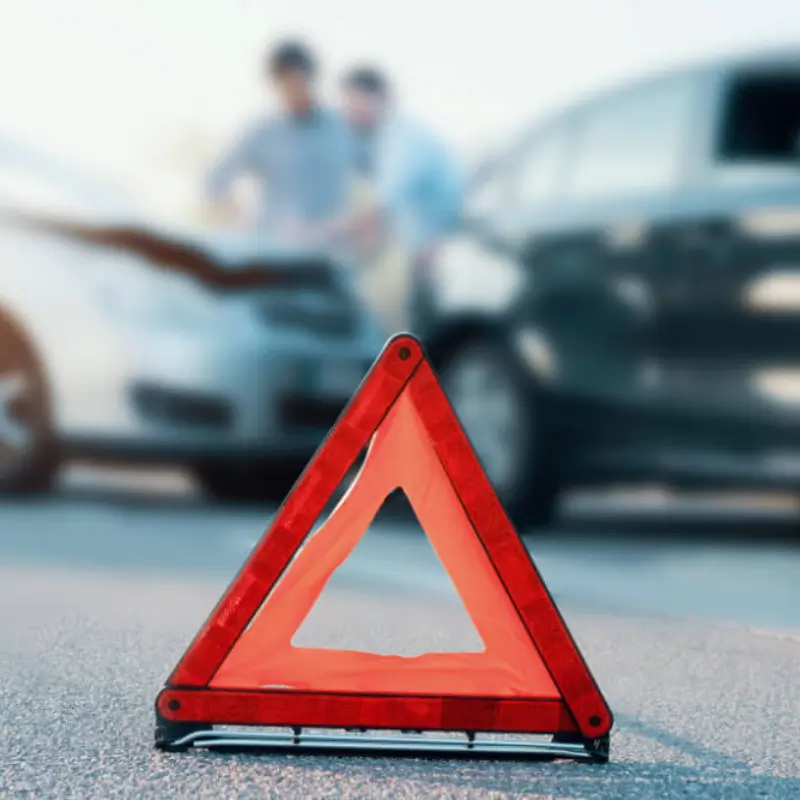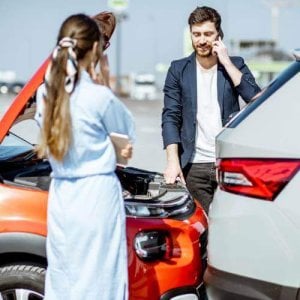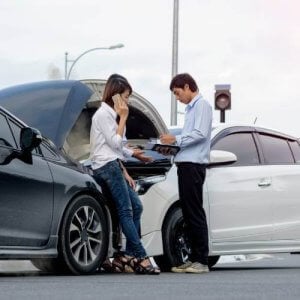Home / Compare Car Insurance / What to do in a car acci…

Key takeaways
Getting into a car accident is a fear of many drivers in Australia. Here are some things you may need to consider if you’re involved in an accident:
- Look after the safety of yourself and others when handling a vehicle left in a dangerous position.
- When making a claim following a car crash, it’s helpful for your insurer if you provide as much evidence as possible from the scene.
- Saying something as simple as ‘sorry’ could possibly be used against you in an insurance claim as it may be taken as an admission of fault.
- If the driver at fault doesn’t stop, you should file a police report and ask witnesses to provide any details they remember.
Expert tips if you get into a car accident
Our resident car insurance expert, Adrian Taylor, has helpful and safe tips to handle getting into a car accident.

Save your insurer’s contact number
Having your insurer on your phone so you can quickly give them a call if you need to can be a life saver. Do the same with your roadside assistance provider and towing service.
Take photos of the whole scene
If it’s safe to do so, take photos of the incident from multiple angles, including all vehicles involved and a wide shot of the location, to capture as much detail as possible.
Save your insurance policy details to your phone
If you own more than one car but you have them insured through different companies, make sure you note who is insuring which car. It could be handy to take a photo of your policy where it has the details of your car and policy number saved to your phone.
Follow these steps after an accident
We’ve compiled this list of tips and steps to guide you through what to do in a car accident.
Check the safety of everyone involved
 If there are personal injuries, deaths or other emergencies (e.g. a car fire) as a result of the motor vehicle accident, the first thing you should do is immediately call 000 (triple zero) and request emergency services.
If there are personal injuries, deaths or other emergencies (e.g. a car fire) as a result of the motor vehicle accident, the first thing you should do is immediately call 000 (triple zero) and request emergency services.
If there aren’t any immediate emergencies, you still need to make sure that everyone involved in the accident is safe and attend to any injured people. Check all impacted cars to see the extent of the damage and put on your hazard lights if necessary to avoid further incidents.
Report the accident to the police
Depending on the accident’s severity and circumstances, you may need to call the police and provide accurate details of the accident, including time and date, location, contact details of all parties and the extent of any accident injuries. It might be necessary to call a tow truck to move the damaged vehicles, and you should consider calling your insurer for advice on who to contact for towing. Officers from the local police station might also help with road safety and direct traffic at the accident scene.
Gather information from the other driver and witnesses
Regardless of who’s at fault for the collision, try to gather as much information about the other driver as you can, including their name, phone number, car registration number, insurance information (e.g. provider, insurance number, policy details) and drivers licence number. In return, you should give them the same details to assist them with their car insurance claim. You should also get the details of any witnesses to provide to your insurer.
Things get a little tricky if the driver at fault didn’t stop. If this happens, you should file a police report and ask witnesses what details they remember, so you can hopefully identify the driver as they’re responsible for the damages. If they don’t have car insurance, you might need to get legal advice about the avenues available to you.
Don’t admit fault
Choose your words carefully when interacting with the other driver. Saying something as simple as ‘sorry’ could possibly be used against you in an insurance claim, as it may imply an acknowledgement of being at fault. Likewise, saying ‘I didn’t see you’ can also be deemed an admission of guilt.
Instead, ask questions such as:
- Do you need medical attention?
- Has someone notified the police?
- What are your insurance details?
Take pictures
Photographic evidence of damages could be very useful. Along with witness accounts, pictures can help you in the case where fault is disputed and may prove the extent of damage for insurance quotes. Likewise, ask if witnesses have photos, video or dashcam footage of the incident that they can share with you.
Call your insurance provider
After collecting evidence and the details of other parties involved, it’s recommended that you call your insurance provider at the earliest opportunity to ensure your claim goes through as quickly as possible.
It’s important to note that if you‘re deemed responsible for causing a car accident, your insurance premium may increase at renewal. If you’re at fault for the accident or if you cannot identify the other participant, you may also have to pay an excess for the claim.
Your car insurance policy must have been in place before the accident to make a claim for any damages.
If you don’t have car insurance, there may be other options available to you.
Important to know
What to do when you have a minor car accident
Whether a minor bingle or a light rear-ending with another motorist in a carpark, always check to see if everybody involved is uninjured and safe. After this, make sure you exchange details with the other driver or parties involved in the vehicle crash or road accident.
These should include:
- The names and contact details of the other people involved
- The details and statements of any witnesses
- The other driver’s insurance provider and policy details
- The make, model and registration number of all other vehicles involved
- A police report (if police assistance is required).
You’ll need to provide these details (as well as a description of what happened, and photos or videos of the damage if you have them) to your insurance provider to assist with the claims process.
What to do if your car is in a dangerous position
Sometimes, an accident can leave your or the other driver’s car in a dangerous situation (e.g. if it’s on fire, oil has spilt, or the engine has overheated). When this happens, these tips could help:
- Pull over as soon as it’s safe to do so, making sure your vehicle is clear of any traffic flow.
- Turn off the engine and turn on your hazard lights.
- Get everybody out of the vehicle through the side facing away from traffic and stay at least 30 metres away. If it’s not safe to exit, remain in the car and ensure all occupants are secured with seatbelts.
- Pop your bonnet when it’s safe to do so and keep it up to indicate an incident to passing motorists.
- Call for emergency services if you have access to a phone.
It’s important to note that you should only do what you’re physically capable of. If you’re injured or assisting will put you in danger, wait until the authorities and emergency services arrive. If your car requires towing, you may want to call your insurer for advice on who to contact.
At fault and not at fault car accidents
Not at fault car accident
 Suppose you’ve been in an incident and you’re fairly certain that it wasn’t your fault. You should inform your insurance provider of the car accident and provide plenty of detail and evidence about what happened, particularly if it proves that it was not your fault. Your insurance company will then work with the other party’s insurer to determine who was at fault for the accident and, therefore, which insurer must pay the repair costs of any damage caused.
Suppose you’ve been in an incident and you’re fairly certain that it wasn’t your fault. You should inform your insurance provider of the car accident and provide plenty of detail and evidence about what happened, particularly if it proves that it was not your fault. Your insurance company will then work with the other party’s insurer to determine who was at fault for the accident and, therefore, which insurer must pay the repair costs of any damage caused.
The way excess works in this scenario can differ between insurers. Some may pay for your damages to be repaired or replaced and withhold your excess until the fault is determined; it’ll then be reimbursed to you if it’s determined to be the other driver’s fault. Other insurers may not charge an excess at all if they’re sure that you’re not at fault for the accident.
At fault car accident
If you are deemed to be at fault, you would need to pay the excess for your damages claim. However, if you don’t have car insurance, you may be liable to pay for all repair or replacement expenses of the other driver’s vehicle.
On the other hand, if you believe the other party contributed toward the accident, you have the right to dispute the claim outcome using your insurer’s dispute resolution process.
Claims questions
How to claim car insurance after an accident
No matter your level of car cover (comprehensive car insurance, Third Party Fire and Theft or Third Party Property Damage), contact your insurer and tell them about the accident to get the ball rolling on your claim.
You can generally make your claim either online through your insurer’s customer account portal (or even app) or over the phone with your insurer. This is when you provide photos (if you have any), details, police reports and any other evidence of the incident (e.g. car crash, a break-in).
Your insurer will take this evidence, build a case for your claim and assess whether or not it can progress according to the terms of your cover.
Your insurer should keep you updated on the progress of your claim. If you’re unhappy with the outcome of your claim, there are steps you can take to dispute the outcome.
Someone hit my car; whose insurer do I call?
You should always call your own insurer and give them as much detail as you can about the road accident. If it’s determined that the other driver is at fault, your insurer will likely organise with the other driver’s insurer to cover any damages to your car.
If the driver (or motorbike rider) who hit your car can’t be identified (e.g. they drove off before you could exchange details), you may need to pay an excess for your claim even if it wasn’t your fault. Be sure to check the Product Disclosure Statement (PDS) of your policy to see how you’re covered for damage in these circumstances and any excesses that may apply.
Is there a time limit on insurance claims?
There are no strict limits on how long after an accident you can claim for damages. However, you should notify your car insurer as soon as you can to start your claim so repairs or replacements can be arranged quickly.
Keep in mind you should report the incident as soon as you are able to. Generally, each state and territory has different time frames for you to lodge a traffic accident matter with the police.
Check your policy’s PDS and any disclaimers to be sure of any time limits to lodge a claim for a car accident.
Meet our car insurance expert, Adrian Taylor
As a General Insurance expert with over 13 years’ experience in financial services, Adrian Taylor is passionate about demystifying car insurance for consumers, so they have a better understanding of what they’re covered for. Adrian’s goal is to make more information available from more insurers, to make it easier to compare and save.


